Introduction
The skin represents the primary barrier between the human protoplasm and the entropy of the external environment. Histological, the skin is divided into the epidermis and the dermis. Epidermis consists of five histological strata form superficial to deep. The layers are the (1) Stratum Corneum, (2) Stratum Lucidum, (3) Stratum Granulosum, (4) Stratum Spinosum, (5) Stratum Germinativum [1].
The keratinocyte, the preponderant epidermal cell, is generated in the stratum germinativum and eventually desquamates (slough) when it reaches the stratum corneaum. The dermis underlies the epidermis and its vascular network functions in thermoregulations & provides metabolic support for the vascular epidermis. Fibroblast synthesizes supportive and structural polymers, including ground substance, collagen and elastin. Skin appendages include sebaceous glands, hair follicles and sweat glands [2].
Full-thickness skin grafts are commonly used as part of the lower rungs of the reconstructive ladder [1]. The generally accepted rules for their use have been as follows: (1) to harvest the graft from an adjacent or nearby donor site (when possible) for good color match, and (2) to defat the graft as completely as possible to minimize the distance for imbibitions and to maximize graft take. However, although full-thickness skin grafts exhibit less secondary contraction than their split-thickness counterparts and are, by definition, thicker than splitthickness skin grafts, a full-thickness defect that includes underlying adipose or other soft tissue is often inadequately reconstructed from a contour perspective and the characteristic patch-like appearance of a skin graft with respect to color match [2-4].
Skin grafting is a technique for the transfer of cutaneous tissue from one site of the body to another, often to cover large defects. Depending on the thickness of the dermis of graft that is harvested, skin grafts are defined as full-thickness or split-thickness [2-4].
Infection is the main hindrance to good wound healing, among other factor. Rifamycin has been used as a topical antibiotic on burns for more than twelve years in many Hospitals [2-4].
Burn wound is a coagulative destruction of the surface layers causes by heat, chemical agents or irradiation. Burns compromises the major body defense mechanism - the skin, as well as depression of humoral and cell mediated immunity. This makes a burn patient more prone to local and systemic infections [3-5].
Methodology
From the universe of study of 10 patients operated on for microsurgical flaps in which the donor or recipient area needs a reconstruction by gross area using partial thickness grafts, placing negative pressure therapy as a support method for integration of the graft for 7 days, one Once the healing time is over, the graft recipient area is marked by quadrants placing in the upper external quadrant (free evolution) without adjuvant, in the lower External quadrant applying Rifocin, in the lower internal quadrant applying Italdermol, and in the upper internal quadrant applying Aloe Vera, measuring integration and function of the graft at 7 days (only 1 intake of the recipient area without adjuvant), at 14 days 4 intakes will be made, that is, 1 from each quadrant, and on day 28, a sampling is also carried out, and a biopsy is taken through a circular 4 mm punch.
In the analysis of the Integration of the Grafts, it was carried out by means of 4 mm circular biopsies and analyzed by Histopathology; Analyzing cell migration, capillary bonding process and growth, collagen fiber arrangement.
Analysis
We analyze 10 patients, and present the evolution in two particular cases, doing the follow-up of the biopsies of the fourth quadrants, one with nothing (just oil), the second one with aloe vera, the third one is italdermol and the fourth one and the main purpose of this study is Rifocin, the follow up during the seven day, the fourteen day and the twenty eight day follow up.
We analyze 10 patients by 35 days, after the integration of the graft, in donor and bloody areas, by the year 2020 and 2021, in the Service of Plastic Surgery, of the General Hospital of Mexico.
Results
The analysis of this study, begun with the explanation of the physiopathology of the organization of the Rifocin during the integration of the graft, but we realize during the objectives of the study, that comparing the use of aloe vera, and Italdermol with nothing and comparing by 7, 14 and 28 days, by the biopsies during a punch (Graphic 1) (Table 1) (Images 1-11).
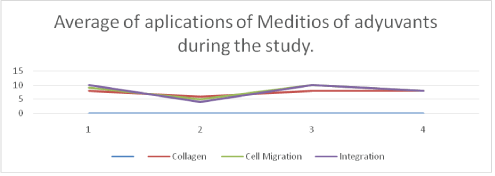
Graph 1: Average of applications of medications of adjuvants during the study.
The progression of the collagen in the 4 groups were identified by the microscopic view from the pathologist, and the cell migration were more important in the first group, of nothing located.
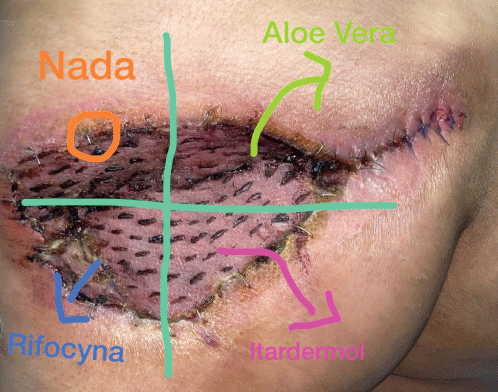
Image 1: Patient #1 with a bloody area in buttock, with thin graft integration, in the 7 day after the surgery.
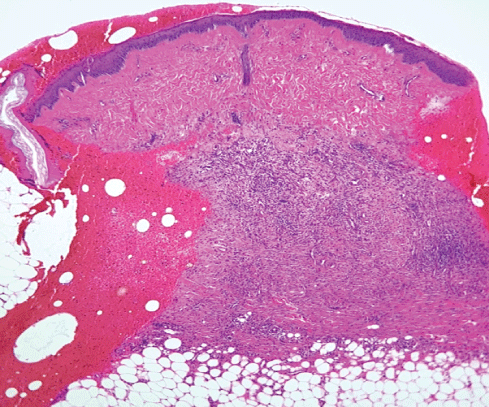
Image 2: Patient #1 (7th day) in the microscopic view, with Intense acute inflammation in the deep dermis and subcutaneous cellular tissue.
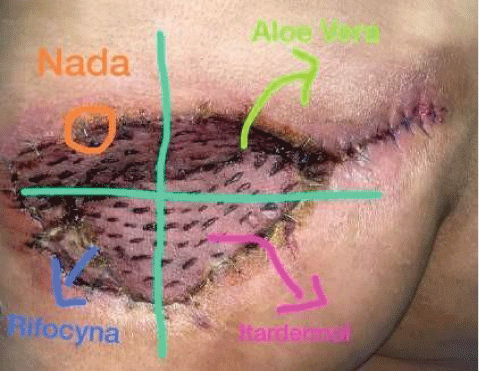
Image 3: Patient #1 with a bloody area in buttock, with a thin graft integration, in the 14 day after the surgery.
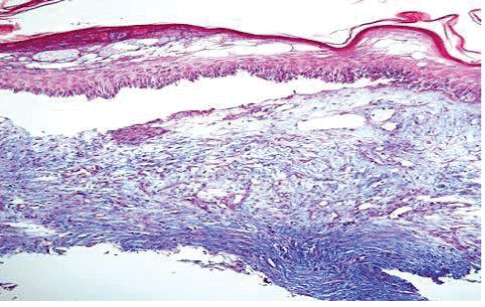
Image 4: Microscopic View at 14 day Post, at nothing zone, with; Acute and moderate chronic inflammation in the superficial and deep dermis.
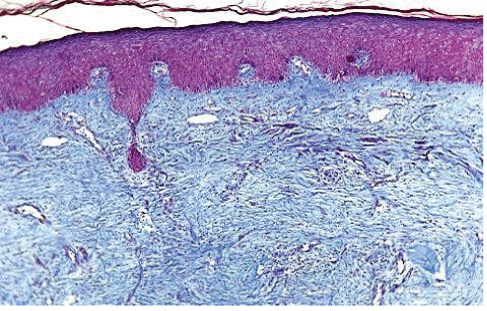
Image 5: Microscopic View at 14 day Post, at the Aloe Vera, Acute and mild chronic inflammation in the superficial and deep dermis.
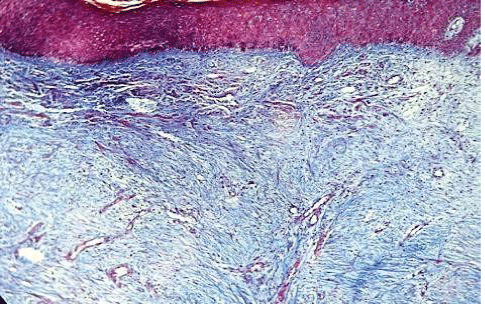
Image 6: Microscopic View at 14 day Post, with Ryfocin, Moderate chronic inflammation in the superficial dermis.
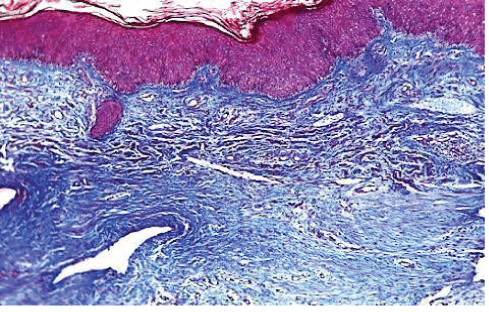
Image 7: Microscopic View at 14 day Post, with Italdermol, Acute and mild chronic inflammation in the superficial and deep dermis.
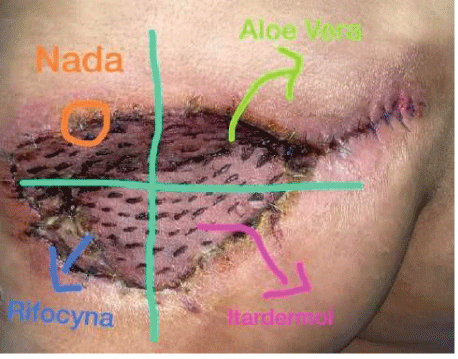
Image 8: Patient #1 with a bloody area in buttock, with a thin graft integration, in the 28 day after the surgery.
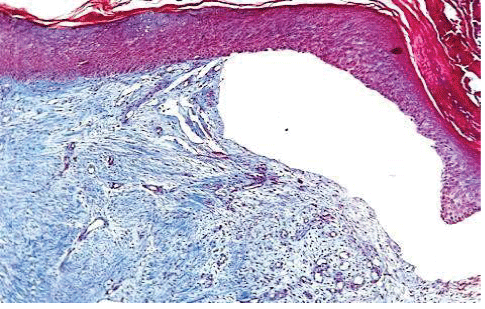
Image 9: Microscopic View at 14 day Post, with nothing, Acute and moderate chronic inflammation in the superficial and deep dermis, with moderate edema.
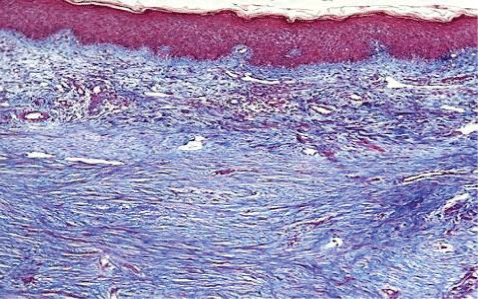
Image 10: Microscopic View at 14 day Post, with Ryfocin, Moderate chronic inflammation in superficial and deep dermis with production of matrix by collagen.
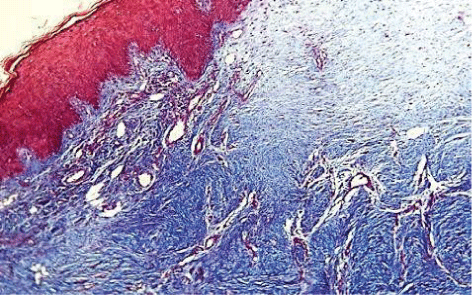
Image 11: Microscopic View at 14 day Post, with Italdermol, Moderate chronic inflammation in the superficial dermis and mild chronic inflammation in the deep dermis with production of matrix by collagen.
| DAY |
7 |
14 |
28 |
|
Nothing |
Intense acute inflammation in the deep dermis and subcutaneous cellular tissue with few lymphocytes and macrophages (mild chronic inflammation). |
Acute and moderate chronic inflammation in the superficial and deep dermis. |
Acute and moderate chronic inflammation in the superficial and deep dermis, with moderate edema. |
| Aloe Vera |
N/A |
Acute and mild chronic inflammation in the superficial and deep dermis. |
Mild chronic inflammation in the superficial dermis with mild edema and collagen matrix production. |
|
Italdermol |
N/A |
Acute and mild chronic inflammation in the superficial and deep dermis. |
Moderate chronic inflammation in the superficial dermis and mild chronic inflammation in the deep dermis with production of matrix by collagen. |
| Ryfocin |
N/A |
Moderate chronic inflammation in the superficial dermis. |
Moderate chronic inflammation in superficial and deep dermis with production of matrix by collagen. |
Table 1: The analysis of the use of aloe vera, and Italdermol with nothing and comparing by 7, 14 and 28 days, biopsies during a punch.
During the study and the follow up of this study, we discover, microscopically; the Rifocin has more cell migration during the first 7 day, but after that those cells where not functional and fibroblast were not produce any more collagen, so the integration is not the same after 28 days, the graft begin to disappear.
By the Aloe Vera we se better results, we see more cell migration in his 7, 14 and 28 day, but the distribution get stopped in the 14 days, the fibroblast were not producing more collagen, but the integration were in better order than Rifocin, and the same as the nothing area.
By the use of Italdermol, the cell migration were less than the others groups, and the disposition of the lines of collagen where in better order, less than the aloe vera group, this group did not have an progression, the cell migration, the collagen lines were stopped during the study, but the integration were in a normally disposition.
In the group control, that we did not use something, the cells migration acts like a normal wound, the disposition of the collagen lines where less than others groups, but it where more differentiation in the day 14 and 28 of the study, these group has the best result in the integration by the 28 day (Image 12).
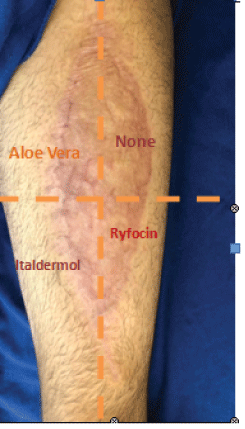
Image 12: The donor site of an ALT Flap, with a 28 days follow up, with more evidence in the none and aloe vera zone.
Discussion
The Rifamycin is a Synthetic derivative of Rifamycin B isolated from Streptomyced mediteranei highly active against Staph. aureaus & albus and Clostridium welchii. Rifamycin is a soluble in organic solvent and in water of acidic PH.
The bactericidal concentration range from 3 to 12 ng/ml to Staph. aureas, N. meningitidis and Haemophilus influenzae. Minima Inhibitory Concentration (MIC) range from 0.1 to 0.8 mg/ml. In concentration of 0.005 to 0.2 mg/ml, it inhibits the growth of M. Tuberculosis in vitro M. kansasii- inhibited by 0.25-1 mg/ml [1].
The mechanism of action is inhibit the DNA-dependent RNA polymerase of mycobacterium and other microorganism by forming a stable drug enzyme complex, leading to suppression of initiation of chain formation (but not chain elongation) in RNA synthesis. More specifically, the B-subunit of the complex enzyme is the site of action of the drug, although Rifamycin binds only to the holoenzyme. Rifamycin can inhibit TNA synthesis in mammalian mitochondria, but considerably higher concentration of the drug is required than for the inhibition of the bacterial enzymes. In higher concentration, is can also inhibit viral DNA depend RNA polymerases and reverse transcriptase [1-3].
The discover in 19th century of chemical preservatives and disinfectants, as well as a better understanding of the nature of infection and inflammations, allowed, increased control of wound infection. In the 20th century, the discovery and development of potent antimicrobial agents with high specificity, improved the management of infected wound. There is relentless emergency of antibiotic resistant strain of pathogens, often with multiple antibiotic resistances. This, followed by the diminished effectiveness of current therapies, a careful consideration of antibiotic used in treatment options is very important. Researches carried out on its use on burn wound are usually as a parental antibiotic not topical use [2-3].
An infection in a wound outbreaks and were related to contaminated hydrotherapy water. In each of the outbreaks the causative microorganisms was resistant to the topical antimicrobial agent in use at the time of the outbreak.
From the mid 1980’s through the present, grafting has replaced the earlier exposure therapy that made use of hydrotherapy. Gradual debridement until a bed of healthy granulations tissues has developed is followed by coverage with autologous skin grafts [3-4].
Skin grafting is the transfer of autologous skin cells left in anatomic order but without an intact blood supply. Therefore time and the recipient surrounding conditions limit the vitality. The operative procedure allows for nearly immediate coverage of large wound areas. Meshed grafts allow further expansion of skin but leave multiple small wounds that are re-epithelialized, mainly from the mesh within a few days. Skin can also be expanded through multiple small skin island grafts (as in Reverdin’s technique) that stimulate granulation tissue, probably by excreting growth factors [3-5].
In Split-thickness skin graft (STSG), keratinocytes on the basal layer show high proliferation rates, which may ultimately stimulate growth factor described: (1) serum imbibition; (2) revascularization; and (3) maturation.
They are - further classified according to their thickness into thin (0.15-0.3 mm, Thiersch-Ollier), intermediate (0.3-0.45 mm, BlairBrown), and thick (0.45-0.6 mm, Padgett). Skin grafts thicker than 0.6 mm usually correspond to full-thickness skin grafts and are called Wolfe-Krause grafts [5].
Skin grafting is a very common procedure, based on removing one fragment of the skin of a region in the body, and transplanting it in the region of a complicated wound. The use of skin grafts is actually used to treat different pathologies, for example, after a deep burn lesion, or in large, open wounds that cannot be well front fronted and need more tissue to achieve an optimal cicatrization. The after care for skin grafts is crucial for the ideal development and cicatrization of the lesion, and a high priority caution to take is to avoid the injury to be infected.
For the ideal cicatrization of skin grafts, there is a large amount of topic and systemic drugs that are currently used, and in this article we will analyze the effectiveness and safeness of three in particular, Aloe Vera, Rifocin and Italdermol (Gentamicin and Triticum vulgare) [2].
The first to mention is Aloe Vera, a herbaceous plant whose origins go back to the Egyptians and is used currently in a form of industrialized gel. The use of this plant for medical purposes has been variating for different illnesses, but majorly for treatment of skin disease. And the use of this plant may not be underestimated, for there have been a lot of clinical trials and studies that can prove that the use of Aloe Vera can actually inhibit thromboxane, reducing inflammation, reduce the production of histamine in the skin, therefore reducing irritation and itchiness; also it can increase the production of cytokines (like IL-10 and TNF-alpha), but inhibiting the action of IL-6, Il-8. Other mechanisms are in charge of stimulating the production of collagen by stimulating the proliferation and migration of fibroblasts and keratinocytes, also incrementing the viability of these cells. All of these observed processes lead to an increase in flexibility and a reduction of the fragility of the skin that are optimal for wound healing, specifically referring to healing of skin grafts, it has shown to accelerate the process, but not the relief of pain [6].
Although for skin grafts and other postoperative wounds Aloe vera may not be the ideal treatment, for it is shown that its effectiveness increases when treating chronic lesions, such as psoriasis, ulcers, herpes lesions and chronic anal fissures, with a similar effectiveness rate as petroleum jelly gauze dressing and silver sulfazaladine; and the advantage of the low cost in comparison to the previously mentioned treatments [2,5,6].
With the effectiveness of Aloe Vera explained, the next treatment for the proper healing and conservation of skin grafts to consider is Rifocin. Rifocin is the commercial name for rifamycin 1%, in the presentation of spray and ointment, for local use in the superficial cleaning of the wound or infiltrating by injection. Rifamycin is an antibiotic produced by the bacteria Streptomyces mediterranei, it inhibits prokaryotic DNA-dependent RNA synthesis and protein synthesis of bacteria. It is effective against gram positive and gram negative bacteria, and it has shown exceptional effectiveness against E. coli and mycobacterium. It has a great tissue and serum availability and can be used parenterally, and in case of skin grafts - topically. Some bacteria, like Enterococcus faecalis and S. aureus have shown some resistance [2,6,7].
The indications of use of rifocin are infected wounds, abscesses and ulcers, pyodermatitis, fistulous tracts, furunculosis, postoperative wounds, and burnts, also, poor prophylactic treatment of wound infection [8].
The use of antimicrobials in the prevention of infection of skin grafts is essential, especially in patients with high risk of infection, such as diabetics and immunocompromised. Considering that an infected graft cannot thrive, and then the quick treatment of the infection is fundamental for proper healing [8].
Rifocin has not shown many adverse effects, or serious ones, but it is important to always consider the possibility of the presentation of pain, burning sensation, itch, and erythema in patients under treatment with rifocin, and can have interactions with cyclosporine. It is recommended for it not to be used in large body areas [6-8].
Another topic drug commonly used for the recovery in skin lesions such as skin grafts is Italdermol, a commercial name for the combination of Gentamicin and an extract of Triticum vulgare [7,8].
The indications for the use of Italdermol are all alterations of dermic cicatrization, that need reactivation of proliferation processes, as may be burns, ulcers, badly healed wounds, dermatitis, wounds with signs of infection, abrasions, dehiscent surgical wounds or with delayed healing and for secondary intention wound closure [9].
Titricum vulgare is a plant from the category of phytostimulins. The way the aqueous extract of Titricum vulgare. Repairs tissue is through stimulation, formation, maturation and migration of fibroblasts, which leads to quick synthesis of granulation tissue and re-epithelialization of the wounds. In more detail, this extract stimulates chemotaxis, maturation and mitosis of fibroblast and endothelial células of the dermis, DNA synthesis; It also works as an antibacterial mainly against gram negative bacterias and Pseudomonas aeruginosa, which is a common etiology of skin infection [9].
This leads to optimal conditions for the wound to heal and reduces the potential need to use other drugs that may have adverse effects in this process, and the potential need to deal with an infection. Titricum vulgare will not be absorbed systemically, which implies that there will not be any effects at this level [8-10].
Gentamicin, the other component of Italdermol is an amino glycoside antimicrobial, with great reach for skin infections mostly caused by gram positive bacteria’s such as Staphylococcus epidermidis and group A Streptococcus, gram negative bacteria’s such as P. aeruginosa and Aerobacter aerogenes [9].
The action of gentamicin is because the capacity to cross the bacterial cell membrane, joining irreversibly to 30”and 50S subunits of bacterial ribosomes, which does not allow protein synthesis by bacterias leading to its death. Gentamicin applied topically does not have any systemic effects, and the absorption is increased by the presence of a lesion in the skin, which makes it possible to have systemic effects if we are treating a large skin area [8-10].
The application of Italdermol may vary from once daily to twice, and it is administered using a gauze. The adverse effects produced by the use of Italdermol may be hypersensibility, pruritus, edema and erythema, which are not expected to be serious and may not need the suspension of the treatment [9-11].
Conclusions
Topical use of Rifocin on skin graft interface during the integration, completing until a 100% the previous, avoiding lack of infection, and humidity, principals’ etiologies of disintegration skin graft. We consider using Rifamycin, because is cheaper, easy looking for, remove and repair damage tissue to enhance the process of wound healing and avoid useless expenses from patients.
During the study, we observe by microscopically and macroscopically that the group control (of nothing use) and the aloe vera, has more cell migration, better disposition of the collagen lines, and better integration result, and the Rifocin at the day 14 destroys more collagen lines and not contribute to organize the migration cells, so the integration were disappeared by the day 28.
In our hospital we prefer to use the rifocin, but in this study we analyze that rifocin is a better option in the first day for a better cell migration, but after the day 9, everything will get disappeared and the integration will not be stabilized.
The conclusion is to use some normal oil, just once a day, of could use aloe vera by once a day, and will get the better result in the integration by macroscopically and better cell migration, and collagen lines in microscopically














